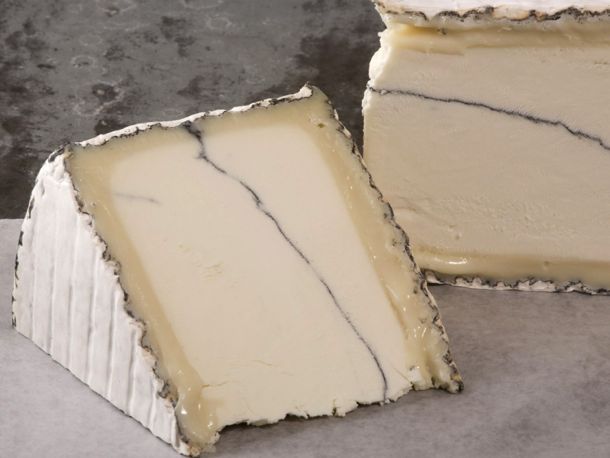Goat cheese is a popular addition to pizzas, salads and sandwiches. You have probably enjoyed the fresh, creamy, tangy flavor of a strong soft goat cheese paired with caramelized onions, candied nuts or a good bottle of wine. But there is so much more to goat cheese than this! There many aged goat cheeses including blue goat cheese, hard cheeses and even ash covered goat cheese.
For the ever-growing number people who are lactose intolerant or suffer allergies to cow milk, goat cheese is a healthy option that allows them to enjoy a bagel, lasagna or pizza again. Even for those of us who don’t suffer ill effects from cow dairy products might consider adding more goat cheese to our diet for two simple reasons:
- Goat cheese is delicious and is available in many varieties and textures.
- Goat cheese is healthier than cheese made from cows milk.
This article will tell you everything you ever hoped to learn about goat cheese, from its origins dating back thousands of years to the nutrition facts to the different types and even how to make your own goat cheese at home.
- Health Benefits of Goat Milk Cheese
- A Brief History of Cheese
- Goat Milk Cheese Types
- What to Do with Goat Milk Cheese
- How to Make Goat Milk Cheese
- Goat Milk Cheese Recipes
Health Benefits of Goat Milk Cheese
Goat milk is full of health benefits, many of which are imparted to the cheeses made from it.
- Goat cheese is easier to digest for those with lactose intolerance.
While goat milk does contain lactose, it also has enzymes that help digest the lactose. It is also unique in that the fats don’t separate in goat milk, making it more easily digested in your stomach. Look for goat cheese made with raw goat milk for the most digestive benefits. - Goat cheese provides easily utilized vitamins and minerals.
Research shows that goat milk improves nutrient absorption in part by increasing the bio availability of essential minerals and vitamins like potassium, vitamin B and niacin. - Goat cheese is full of heart healthy fats.
Goat milk has medium chain fatty acids that actually help boost healthy cholesterol and decrease the adhesion of cholesterol to arterial walls.
A 2011 study published in the Journal of Dairy Science demonstrated that goat milk improves the uptake of iron in the body. It is believed that enzymes in goat milk also boost the bio availability of other important minerals. Goat cheese made with raw, unpasteurized goat milk retains these valuable enzymes and facilitates mineral absorption in your body.
Goat Cheese Nutritional Facts
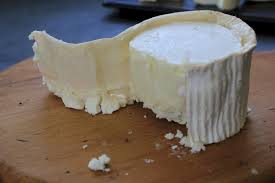
Image courtesy of asweetandsavorylife.com
Goat cheese is still a rich, indulgent food that is high in calories and fat. But compared to a common American favorite, cheddar cheese, it is a much healthier option. Let’s take a look a the nutritional breakdown:
The following nutritional facts are based on a one ounce serving of soft, fresh goat cheese or standard cheddar cheese.
- Calories– Goat Cheese: 70 calories, 45 fat calories. Cheddar Cheese: 110 calories, 80 fat calories.
- Fat– Goat Cheese: 5g per ounce, 3g saturated. Cheddar Cheese: 9g per ounce, 6g saturated
- Sodium– Goat Cheese: 65mg per ounce. Cheddar Cheese: 170mg per ounce.
- Goat cheese is also higher in vitamins D, K and the B vitamin Riboflavin, as well as the minerals thiamine and niacin.
If you are looking for a rich and creamy cheese to enjoy without guilt, reach for the goat cheese.
A Brief History of Cheese

Image courtesy of theguardian.com
Goat milk was likely the first type of milk to be made into cheese. Goats and sheep were domesticated between 10,000 and 8500 B.C., at least 1500 years before the domestication of cattle. They spread rapidly throughout human settlements because they adapt easily to different climates and diets. It is likely that goats arrived in many parts of Europe before people settled there, because they are natural wanderers.
Interestingly enough, cheese has a rich and lengthy history in the Middle East and Europe, while it is a relatively new addition to New World diets and never seemed to catch on in Asia, even in modern times.
The Accidental Discovery of Cheese
7500 B.C. (Give or take a few millenia): a traveler sets out across the desert. He carries a bag made from a sheep’s stomach. It is full of milk. As he trudges through the hot sun all day, the rennet in the stomach combines with the milk and is warmed by the intense heat. When our traveler stops to rest for the evening, he discovers his milk has separated into thin liquid whey and soft, lumpy curds. His hunger is intense, so he drinks the liquid and eats the solids, discovering to his surprise the delicious taste of fresh soft cheese curds.
We can’t know for certain that this is how cheese came about, but it seems a plausible theory. We do know that by the time the Roman Empire began spreading its ambitions across Europe cheese was firmly established in many local diets.
Here are some of the interesting milestones in history of goat cheese:
- 10,000 BC: Toe bones of a goat found in Iran in remains of an ancient town suggest that goats had already been domesticated.
- 5000 BC: Archaeological evidence suggests cheese was being produced in Poland.
- 2000 BC: The Egyptians depict cheese making on tomb walls.
- 800 BC (roughly): Homer’s Odyssey depicts the Cyclops making goat cheese and sheep cheese.
- 77 AD: Pliny the Elder devotes an entire chapter to cheese in his Natural History, including an entry on smoked goat cheese.
- 732 AD: After Charles Martel stops the Moors advance in France many of his Saracens stayed behind to raise goats and make goat cheese.
- 1815: The first cheese factory opens in Switzerland, producing Gruyere commercially.
- 1841: The first American cheese factory is established in Wisconsin by Anne Pickett.
- 1857: Emile Duclaux discovered pasteurization which made cheese making much easier.
- 1895: The dairy Soignon is founded in the Poitou-Charentes region of France and became one of the leading centers for goat cheese.
- 2009: The Protected Designation of Origin lays out strict specifications to guarantee that each goat cheese is produced traditionally. There are currently 14 French goat cheeses that bear this label.
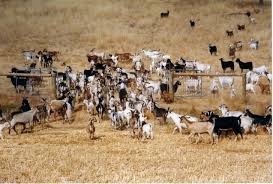
Image courtesy of margaretmuirauthor.blogspot.com
Cheeses were historically produced in homes and later in monasteries throughout the Middle Ages. It is only in the last century that cheeses with consistent flavor have been developed. Two big changes led to the modern, mass produced cheeses we are familiar with today:
- Rennet became mass –produced in the 1860’s.
- Around 1900 pure microbial cultures were developed to replace recycled whey.
These innovations allowed cheese makers to standardize their cheeses. For the first time customers in San Francisco, New York and Paris could all purchase the same goat cheese. There are still many goat cheese producers who make small batches of unique cheeses, especially in France. However, most of the goat cheese consumed in the Western world is a standardized fresh cheese, often called Chévre. You may be surprised to learn how many other types of goat cheese exist.
Goat Cheese Types
There are many ways to classify goat cheese. I’ve broken them down into three simple types: fresh, brined and aged.
Fresh Goat Milk Cheese
This is the most common goat cheese. The texture is usually smooth, almost like cream cheese, and the cheeses commonly come in logs, disc shaped rounds or small pyramids. Herbs and spices are often mixed into fresh goat cheese.
What is Chévre?
Chévre is the French word for goat. Traditionally, farmers who used fresh goat milk to make cheese simply referred to the cheese as chévre. As fresh French goat cheese spread the name stuck with it. There are many different varieties of this soft, classic goat cheese produced throughout France and grouped together under the phrase “the original chévre”. Today there are 3,000 goat cheese producers in France, producing over 110,000 tons of goat cheese annually.
Brined Goat Milk Cheese
These goat cheeses are aged in a salty solution which not only imparts a salty flavor but makes the cheese crumbly in texture. You have probably eaten the most famous brined goat cheese recently: Feta. While this popular salad cheese can be made from goat, cow or sheep milk, it is most commonly made as a goat cheese.
Sirene is the common name for a Bulgarian brined goat cheese that can be made from cow, goat or sheep milk. The milk becomes yogurt before making a soft, Feta-like cheese.
Aged or Hard Goat Milk Cheese
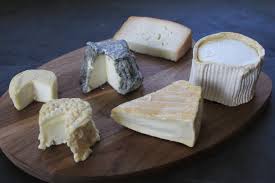
Image courtesy of asweetandsavorylife.com
Aged cheeses gave adventurers and explorers from ancient Arab nomads to Christopher Colombus an important source of nutrition. Fresh milk and cheese go bad quickly, but aged cheeses provide valuable fats, proteins, minerals and even vitamins for months and even years. They were an ideal food for long sea journeys. While aging cheese is no longer a matter of necessity, the unique and powerful flavors of aged cheese keeps the market demand high.
Aged goat cheese can be either soft or hard. Regardless of texture, goat cheeses develop amazing flavors during aging. The tart tanginess of fresh goat cheese fades, leaving a sweet, nutty and sometimes sharp flavor behind.
Here are a few of the best aged goat cheeses available. Try one at your next party:
- Tomme de Bethmale is a distinctive French goat cheese that is aged and pressed till firm. It has a rich, earthy flavor and just a hint of stinky aged cheese deliciousness.
- Bleu du Bocage is an aged blue goat cheese. It is delicate, sweet, salty and rich. The Vendee of Western France, where this cheese originates, it is enjoyed with a dry Riesling, Port or Moscato and bittersweet chocolate.
- Balarina, a Dutch aged goat Gouda, is a popular table cheese. It is sweet with a caramel overtones. Holland also produces amazingly creamy fresh goat Goudas.
- Chabichou du Poitou is a musky, oozy cheese with an edible wrinkled rind that contains the buttery interior that is almost liquid. Despite a strong goat smell, this cheese has a sweet and tangy flavor. Be prepared to make a mess.
- Boucheron is a soft goat cheese with a edible rind. The inner cheese has a bright, tangy flavor that is more intense than a classic fresh goat cheese. The rind is creamy and rich with a smooth butter texture.
- Crottin can be eaten young and fresh or aged into a strong, almost nutty flavored goat cheese. You can even age this Loire Valley cheese so much that it develops a black rind. The people of France have been enjoying this goat cheese since the 16th century.
- Florette is a brie like goat cheese, usually shaped into a hexagon. Compared to other goat cheeses, it has a much creamier and milder flavor, qualities created in part by the use of pasteurized goat milk.

Image courtesy of thitdevietnam.tk
Goat Cheese with Ash
Some of the most unique aged goat cheeses are made with ash. Ash has been used for centuries to make a protective coating around young goat cheeses forming a thick, grey-blue rind that shields the cheese as it ages. Today most goat cheese makers us a mix of activated charcoal and salt, but in the Loire Valley of France, famous for its goat cheese, the ash traditionally came from burning grape vine clippings.
The History of Making Cheese with Ash
Before convenient permeable plastic wraps, plastic coatings and even wax it was challenging to preserve cheese during the transition fresh curds to pungent aged blocks. For a long time cheese aged in the open air, and a large portion was lost to molds growing on the outside of the block. Later on the benefits of coating a young cheese with ash were discovered.
When ash is used on the surface of goat cheese, it:
- Neutralizes surface acidity because ash is an alkaline salt.
- Absorbs excess moisture at the surface of the cheese.
The decrease in acid makes the surface of the cheese more appealing to molds like P. candidum, which forms the smooth white rind of camembert cheese while the drier edge discourages the growth of harmful molds and bacteria.
Ash is Used Mostly for Goat Milk Cheese
Why? Goat cheeses tend to be very soft, weak-bodied cheeses. Firmer cow and sheep milk cheese can be protected by oils or rubs, but goat cheese doesn’t tolerate these rough treatments well. For that reason, a mold rind is commonly used for goat cheeses. Due to the level of lactic acid in goat cheese, the molds grow slowly, exposing the cheese to harmful molds and bacteria. The ash reduces the amount of acid in the cheese, speeding the growth of a healthy mold rind.
Plus it looks really cool, because goat milk produces a snow white cheese that contrasts beautifully with the dark black of the ash. Today activated charcoal is used more frequently than ash because it works more quickly and efficiently.
Valencay
Valencay is a very special goat cheese. You’ll have to go to France to experience the real thing, as true Valencay must be made from raw goats milk and thus cannot be imported into the US. The flavor is woodsy with a sharp tang and a smooth, heavy texture.
Valencay Shaped by Napoleon’s Rage
Valencay used to be shaped like a full pyramid, but it lost its top to the angry sword of a defeated Napoleon. The story goes that Napoleon stopped in the Chateau de Valancay on his way back from a disastrous campaign in Egypt. The pyramid shaped goat cheese he was served for dessert reminded him of his losses in Egypt and threw him into a fury. He chopped the top off the cheese with his sword, and the frightened locals never made a full Valencay pyramid again.
Learn more: The Five Most Popular Goat Cheese Types
What to Do with Goat Cheese
Do you like the taste of goat cheese but don’t really know how to prepare it? Say goodbye to cheese and crackers with these creative ideas for enjoying goat cheese:
- Goat Cheese Pizza: add arugula, carmelized onions, goat cheese and olive oil for an amazing white pizza.
- Goat Cheese Balls: deep fry and eat on top of a salad or in a pita bread.
- Goat Cheesecake: substitute goat cheese for cream cheese in your favorite recipe.
- Picnic Sandwich: goat cheese, avocado and strawberry on pumpernickel bread. Yum!
Here are a few of our favorite goat cheese recipes:
- How to Make Goat Milk Cheese Spread
- Delicious Baked Goat Cheese
- Fried Cheese Rounds
- Best Goat Milk Cheese Pizza
- Yummy Arugula and Goat Cheese Salad

Image courtesy of pbs.org
Now all you need in order to enjoy these delicious goat cheese snacks is a big supply of goat cheese. Fortunately the tangy, soft Chévre style cheeses are simple to make at home. If you decide to keep your own goats to supply fresh, raw goat milk you can have homemade goat cheese on hand all the time. We’ll even tell you how to make the more complex aged goat cheeses so you can really impress your friends and family.
How to Make Goat Milk Cheese
There are many different types of goat cheese which are produced in a variety of ways. Let’s start with the basic steps for making a simple goat cheese.
- Curdle the milk: allow the milk to curdle naturally, or speed the process by adding an acid like vinegar or lemon juice.
- Press the curds: this step removes the liquid and can be as simple as wrapping the curds in cheesecloth and hanging them to dry.
- Flavor and shape the cheese: after the curds are drained you can add any herbs or spices you want, and form the cheese into the shape you want.
- Age and ripen the cheese: depending on the type of goat cheese you want to make, this process could last anywhere from days to years. It could involve a brining solution, a mold or even ash to protect the cheese during aging.
Making Aged Goat Milk Cheese
Fresh goat cheese is easy and fast to make and it can be enjoyed immediately. But aged goat cheese has a rich, subtle flavor that is simply unmatched in the cheese world. You can make soft and hard aged goat cheese at home with a few simple tools and some patience.
History of Aging Cheese
Goat cheese outdates refrigeration by thousands of years. Early cheesemakers were endlessly creative in finding ways to preserve the cheese. Methods included:
- Burying cheese in ash.
- Storing cheese in underground clay containers.
- Floating cheese in oil or whey.
- Hanging cheese in the rafters of a house where it was slowly smoked by the wood heat.
- Storing cheese in caves. Natural and manmade caves are great aging rooms, with year round temperatures of 55°F and 80% humidity.
- Some cheeses were even stored by burying them in animal dung.
Some of these methods, or variations on them, are still used today. Others, like the last, have fortunately fallen by the wayside.
The Secrets to Successful Aging
There are five secret tips to proper goat cheese aging. Follow these guidelines and you’ll produce rich, strong and delicious aged cheeses right at home.
- Drain and Dry the Curds Properly
This is a delicate stage. If the cheese dries too quickly or too much it will lose texture and flavor. If it dries too slowly or stays too full of whey it will break down and possible grow nasty molds or fungi.
There are two keys to proper drying:- Let the cheese breathe: undesirable organisms including the dangerous Listeria can thrive in anaerobic environments.
- Keep the cheese cool: use a lower temperature during drying than you will during aging. Ideally you’ll keep the cheese at or below 45°F.
Under the right conditions draining and drying will take anywhere from two to seven days, depending in part in how much cheese you dry at one time.
- Prepare an Aging Room
If you are planning to sell goat cheese, you will be required to separate pasteurized from unpasteurized cheeses during aging. Even if you are making a small amount of cheese for personal use, you should separate your cheese from other food items to prevent contamination. Blue cheeses should be aged in their own room or fridge, because the blue mold will easily contaminate other cheeses.
The two most common spaces used for aging goat cheese are:- A refrigerator of some type: anything from a mini-fridge to a walk-in cooler works well.
- A home-dug or natural cave makes an ideal aging space due to consistent temperatures and high humidity.
- Salt Wisely
Salt is commonly used to both flavor and help preserve aging goat cheese. Since most modern diets are high in sodium, many goat cheese producers are working hard to reduce the amount of salt in their cheese. When making your own, salt lightly. A rate of 1 teaspoon per quart works well. If a cheese will be aged less than 60 days, you can actually make it without any salt at all. - Choose the Right Shape
Shaping an aged cheese is about more than just appearances. The shape of goat cheese affects how the cheese ages. For instance, small cheeses age more quickly than large ones and can dry out to the point of becoming inedible. Large cheeses age better, but can end up being too heavy to easily manage. - Use the Right Containers for Pressing and Molding Goat Cheese
Only use glass or stainless steel containers and cotton or muslin cloth when working with cheese. Paper, plastics and non-stainless metals can all leach harmful chemicals into your cheese that are not only bad for your health but will taint the flavor of your cheese.If you use a container that does not have drainage holes, be sure to turn the cheese regularly and drain off the whey.
Goat Cheese Recipes
Here is a collection of five amazing goat cheese recipes, fresh, brined and aged.
- The Original Chévre
- Greek Style Feta Cheese
- Goat Ricotta
- Blue Goat Milk Cheese
- Goat Milk Tomme Cheese
Before we get started, there are a couple things to thing about when making goat cheese at home:
- Sanitize everything you use in a goat cheese recipe. The pots, pans, colanders, spoons, aging fridge or room, anything that will touch the cheese should be sanitized. Certain recipes call for cheese cultures or molds, and these are the only organisms you want growing on your cheese.
- Raw vs. Pasteurized goat cheese: any recipe that heats the goat milk over 165°F pasteurizes the cheese. This will make the flavor milder, which is desirable in some cheeses. It also degrades some of the proteins and enzymes present in raw milk which may reduce the digestibility and other health benefits attributed to raw goat milk products. Note: any imported goat cheese you purchase in a grocery store must be pasteurized by law. This means that some cheeses like the French Valencay, will not taste quite the same in the States. You have to travel to France to experience the real thing.
- Rennet is a coagulating substance used in many goat cheese recipes. It helps to firm up the curds. Rennet can be made from the lining of calf stomachs or out a mold. Both the animal and vegetarian forms work equally well.
A Note on Cheese Cultures
Not all goat cheese recipes call for a cheese culture. Many fresh goat cheeses are allowed to curdle naturally, or are encouraged to curdle by adding an acid like lemon juice or vinegar. Other recipes call for a specific starter culture. The organisms in a culture will “ripen” the milk, causing curds to form. They also impart a distinctive flavor to the cheese.
Ready to make goat cheese? Let’s start with a fresh chévre recipe. Remember that you can adjust any of these recipes to make smaller or larger batches of cheese.
The Original Chévre, or Fresh Goat Cheese
2 1/2 gallon raw goat milk
1/2 tsp Chévre culture (for example, you could use a mesophilic DVI Culture “MM”)
liquid rennet
Steps to Making the Original Chévre
- In a heavy bottomed pan, warm the milk to 72°F.If the weather is warm, use the milk at room temperature.
- Add the culture and stir well.
- Add one drop of liquid rennet. If you are making a smaller batch of cheese, using only 1/2 gallon of milk for example, you can add 1/5 of a drop of rennet easily: measure 5 tablespoons of water, add one drop of rennet, stir well. Add one tablespoon of that mixture to your milk.
- Cover and let sit for 18-24 hours. The pot should remain at about 72°F.
- When the milk has coagulated you are ready to make your cheese in one of two ways:
- To make Fromage Blanc (Bag Goat Cheese):Pour curds into a cheesecloth lined colander. Gather the ends of the cloth together and hang for 6-8 hours. Salt to taste and use as cream cheese, or whip in food processor for sour cream.
- To make Chevre: pour off any excess whey. Ladle curds into cheese molds, and place molds on a baking pan to catch the whey that will continue to drain out. If you like, add a dried herbs, spices or garlic before spooning on another layer of curds. Allow to drain for several days, either in the fridge or well covered. Once drained, remove the cheese from the molds, salt the outside lightly and wrap tightly in plastic.
Greek Style Feta Cheese
3 gallons raw goat milk
1/4 tsp mesophilic DVI Culture “MM” or “MA” OR 4 ounces mesophilic mother culture
1 tsp liquid rennet, dissolved in 1/2 cup water
Salt
Brine: 1/2 cup salt per 1/2 gallon of water, boiled and cooled to room temperature.
Steps to Making Greek Style Feta
- Using a double boiler heat the milk to 86°F. In a hot summer kitchen, you may not need an external heat source!
- Add the culture, cover and let sit for one hour at 86°F.
- Add the rennet, stir briskly then let sit for 30 minutes at 86°F.
- Check for a “clean break” by sticking a knife into the curd and lifting straight up. It is ready when the curd breaks around the knife and clear whey fills the hole.
- Without removing it from the pot, cut the curd into roughly 1/2″ pieces. Do this with a long knife from above. Don’t worry if your curds aren’t perfectly shaped.
- Let the cut curds sit for 10 minutes without stirring.
- Gently stir the curd and cut up any pieces you missed before.
- Let the curds sit for 45 minutes at 86°F, stirring once every ten minutes. They will toughen up and lose some of their whey.
- Place cheese curds in a colander lined with cheesecloth.
- Gather the edges of the cloth and tie with string. Hang for four hours.
- Take the cheese down, turn it over in the cheesecloth and continue hanging for about 24 hours. Turning the cheese will make it prettier in the end.
- After 24 hours of hanging, take the cheese down (it will stink up your house, so warn the family!) and cut into cubes 2-3 inches square.
- Sprinkle all sides of the cubes with salt, place in a sealed container (Tupperware is great) and let sit for 3-4 days. Whey will continue to seep out as the cheese firms up.
- Place cubes and whey into a large glass jar. Fill with brine. Cover and refrigerate for at least 4 weeks before using.
Feta cheese will last for months if stored in its brine in the refrigerator. If your cheese begins to crumble or break down in the brine, one of two things happened:
- You didn’t hang the curd long enough.
- You didn’t let the blocks harden long enough in the salt.
If this happens the cheese is still edible. Just remove it from the brine and use it right away. If you leave it in the brine it will only soften more. Proper drying, via hanging and salting, is essential to obtaining crumbly, firm goat Feta. Don’t be discouraged if your first batch doesn’t turn out! Use it like you would a good goat ricotta, and try again.
Goat Milk Ricotta
Traditionally ricotta cheese is made from whey leftover from making other cheeses, but there’s a speedy way to do it if you aren’t making another cheese and really need a good goat cheese ricotta for your lasagna.
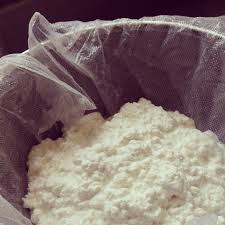
Image courtesy of littleseedfarm.com
Speedy Goat Milk Ricotta
1/2 gallon goat’s milk
2 tbs apple cider vinegar
salt to taste
cheesecloth lined colander (sanitized)
Steps to Making Speedy Goat Ricotta Cheese
- In a heavy bottomed pan, heat goat milk to 195°F.
- Remove from heat. Add vinegar while stirring gently.
- If curds do not begin to separate, place back on heat and heat to no more than 205°F.
- Let curds rest 10 minutes.
- Scoop curds into your cheesecloth lined colander.
- Allow to drain for 5 minutes.
- That’s it! Place into a container and store in the fridge, or use immediately in your favorite recipe.
Blue Goat Cheese
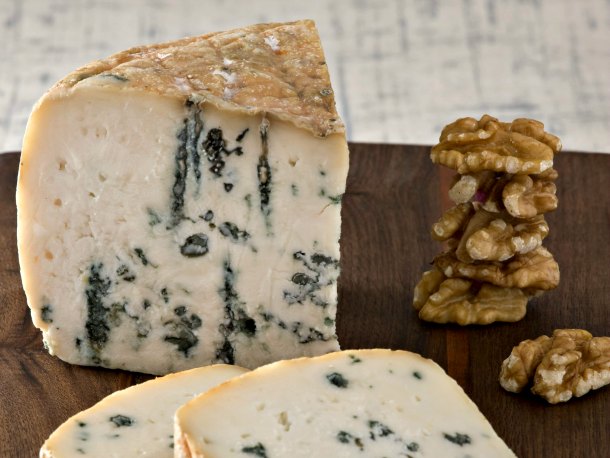
Image courtesy of seriouseats.com
2 gallons goat milk
1/4 teaspoon of Penecillium Roqueforti (Blue Mold)
1/2 teaspoon mesophilic culture MM 100
5 mL rennet dissolved in 20 mL cooled boiled water
2 tablespoons plus 2 teaspoons salt
3 Cheese Hoops or Molds
Steps to Making Blue Goat Milk Cheese
- The day before cheese making, prepare the starter as per package instructions.
- Warm the milk to 86°F
- Add the mold and starter culture and mix well. Leave covered for one hour at 86°F.
- Add the rennet solution and stir gently for one minute. Cover and let sit for 45 minutes at 86°F.
- Check for a “clean break” by sticking a knife into the curd and lifting straight up. It is ready when the curd breaks around the knife and clear whey fills the hole.
- Without removing it from the pot, cut the curd into roughly 1/2″ pieces. Do this with a long knife from above. Don’t worry if your curds aren’t perfectly shaped.
- Let the cut curds sit for 10 minutes without stirring.
- Gently stir the curd and cut up any pieces you missed before.
- Let the curds sit for 45 minutes at 86°F, stirring once every ten minutes. They will toughen up and lose some of their whey.
- Pour the curds and whey into a colander and allow to drain for five minutes.
- Return the curds to the pot and mix gently by hand. Let sit for five minutes.
- Place cheese hoops on a board covered with cheesecloth or wax paper.
- Gently spoon curds into the cheese hoops using a slotted spoon. Fill each hoop just shy of the top. Do this on top of a board or bamboo mat to drain the whey.
- Leave to drain for 15 minutes.
- Cover the top of the hoops with another cloth or paper covered board, grip both boards firmly and turn the hoops over. Turn the hoops every 15 minutes for two hours, then once each hour for two more hours. Leave to drain overnight, covered with a clean cloth.
- In the morning the cheese should feel firm and have pulled away from the edges of the hoop. Remove the hoop and lightly salt all sides of each cheese.
- Let cheeses stand on the board for three days at 85% humidity and about 55°F. They should be salted and turned once daily.
- Use a sterilized skewer or needle to poke 30-40 holes in each cheese. This allows the blue mold to travel through the cheese, creating the distinctive blue veins in blue goat cheese.
- Place a draining mat in a metal or glass container, place the cheese on top and store in a cool (50°F), humid place for 30 days. Turn the cheese one every four days. You should see mold appearing in the first 10 days.
- Continue to age the cheese for 90 days. After the first month, the blue mold will have covered the outside of the cheese, and a red brown smear will appear. Gently scrape the mold and smear off the cheese with a long knife once every 10 days or so.
- After 90 days, scrape the cheeses again and wrap in foil.
- Age wrapped cheeses for another 60 days in the fridge at 36-40°F, turning once a week. You now have a mild blue. For a robust blue goat cheese age for another three months in the fridge.
Goat Milk Tomme Cheese
2 gallon of raw goat milk
1/16 tsp of mesothermic culture MA4002
1/8 tsp liquid rennet
Salt
Brine: 1 gallon water with 2 1/4 lb salt and 1 teaspoon vinegar
Steps to Making Goat Milk Tomme Cheese
- The day before cheese making, prepare the starter as per package instructions.
- Warm the milk to 86°F
- Add the starter culture and mix well. Leave covered for one hour at 86°F.
- Add the rennet solution and stir gently for one minute. Cover and let sit for 45 minutes at 86°F.
- Check for a “clean break” by sticking a knife into the curd and lifting straight up. It is ready when the curd breaks around the knife and clear whey fills the hole.
- Without removing it from the pot, cut the curd into roughly 1/4″ pieces. Do this with a long knife from above. Don’t worry if your curds aren’t perfectly shaped. The smaller the curds the drier your final cheese will be.
- Let the cut curds sit for 10 minutes without stirring.
- Gently stir the curd and cut up any pieces you missed before.
- Let the curds sit for 45 minutes at 86°F, stirring once every ten minutes. They will toughen up and lose some of their whey. The curds are ready to be drained when a handful of the curds squished together hold shape but are still easily separated with your fingers.
- Pour off most of the whey, leaving no more than one inch of whey above the curds.
- Pour curds into a cheese mold or basket lined with cheese cloth.
- Press the cheese at 86°F, starting with light weights and gradually adding more:
- 1 hr. at 15 lbs
- 1.5 hr. at 25 lbs
- 2 hr. at 25 lbs
- remove weights and allow the cheese to drop to room temp
- The cheese is still fermenting after pressing. Keep it at 70°F overnight to finish fermentation.
- Place the cheese in the brine. It should brine for 1 1/2 hour for every pound of cheese. Sprinkle the top of the cheese with salt as it will float above the brine, and turn several times during brining.
- Pat the cheese dry, and allow to dry for 2-4 days at room temperature.
- Place cheese in your aging room at 55°F and 80% humidity
- Turn the cheese each day and look for mold spots. When mold develops, remove it with a dry soft bristled brush. Using natural bristles is best. Continue to do this each day. As the cheese dries you can brush it once every 3-4 days.
- Once the cheese develops a nice rind, it can be aged for another 3 months and is ready to eat.
Extended Reading
Everything to Know About Goat Milk
Watch goat cheese being made with milk fresh from the goat.

